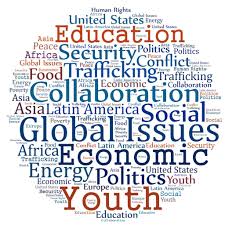Measuring Progress in Global Poverty Alleviation: Key Indicators and Trends
The eradication of global poverty is paramount for sustainable development and a more equitable world. Accurately measuring progress and understanding key indicators and trends are crucial for effective poverty alleviation strategies. This article examines essential metrics and trends, highlighting achievements and remaining challenges.
Extreme Poverty Rates: The most fundamental indicator is the extreme poverty rate, defined as living on less than $1.90 per day. Tracking the percentage of the global population in extreme poverty provides a comprehensive measure of progress in lifting people out of destitution. Consistent monitoring allows for identification of effective strategies and areas needing further attention. Declining rates indicate success, while stagnant or increasing rates signal the need for revised approaches.
Multidimensional Poverty Index (MPI): While extreme poverty rates offer a broad view, the MPI provides a more nuanced understanding. It considers multiple dimensions of poverty, including access to education, healthcare, clean water, and sanitation, offering a richer picture of deprivation. Analyzing the MPI reveals the complexities of poverty and guides targeted interventions to address specific deprivations.
Income Inequality: Progress in poverty reduction must consider not just overall poverty rates but also the reduction of inequality. Monitoring the gap between rich and poor ensures that development is inclusive and benefits all segments of society. High levels of inequality often hinder poverty reduction efforts, necessitating strategies that promote equitable distribution of wealth and opportunity.
Sustainable Development Goals (SDGs): The UN SDGs provide a comprehensive framework for measuring progress. Targets like ending poverty in all its forms and ensuring universal access to basic services guide global efforts. Tracking progress towards SDG targets offers a standardized measure of global efforts and identifies areas requiring increased attention and resources.
Economic Growth and its Impact: Economic growth plays a vital role by creating opportunities for income generation and employment. Monitoring GDP growth rates and per capita income helps assess the impact of economic development on poverty reduction. However, simply focusing on economic growth isn't sufficient; inclusive growth strategies that distribute benefits equitably are essential for poverty alleviation.
Education and Literacy: Education empowers individuals to escape poverty. Monitoring enrollment rates, literacy rates, and access to quality education reveals progress in providing equal educational opportunities. Investment in education is crucial, particularly for girls and marginalized communities, to break the cycle of poverty.
Healthcare and Nutrition: Access to healthcare and adequate nutrition are fundamental. Tracking child mortality rates, maternal health, and access to essential healthcare services gauges progress in these critical areas. Improved health outcomes contribute to increased productivity and improved quality of life, fostering sustainable poverty reduction.
Gender Equality: Gender inequality is both a cause and consequence of poverty. Measuring female labor force participation rates, gender wage gaps, and women's representation in decision-making roles monitors progress in empowering women. Empowering women is critical for overall economic growth and social progress, significantly impacting poverty reduction efforts.
Social Protection Programs: Effective social protection programs, like conditional cash transfers, significantly impact poverty alleviation. Monitoring their coverage and impact provides insights into their effectiveness and guides policy decisions. Well-designed social safety nets can act as crucial support systems for vulnerable populations.
Environmental Sustainability: Poverty alleviation cannot come at the expense of environmental sustainability. Monitoring carbon emissions, deforestation rates, and access to clean energy ensures that development efforts are environmentally responsible. Sustainable development practices are crucial for long-term poverty reduction and ensure a healthy planet for future generations.
Technology and Innovation: Technology accelerates poverty alleviation. Measuring access to information and communication technologies and the adoption of sustainable technologies reveals the transformative potential of innovation. Leveraging technological advancements can improve efficiency, create new opportunities, and drive inclusive growth.
Global Partnerships and Cooperation: Poverty alleviation requires collective action. Monitoring official development assistance and international cooperation assesses the effectiveness of global efforts. Strong global partnerships and collaborations are essential for sharing best practices, mobilizing resources, and achieving shared goals.
Regional Disparities: Poverty rates vary across regions. Monitoring these disparities and access to basic services helps identify areas needing targeted interventions and resources. Addressing regional inequalities is key for ensuring equitable progress in poverty reduction efforts.
Conflict and Fragility: Poverty is exacerbated in conflict-affected states. Measuring conflict incidence and its impact on poverty guides efforts in addressing the unique challenges of these regions. Peacebuilding and conflict resolution are critical prerequisites for sustainable poverty reduction in fragile states.
Community Engagement and Local Ownership: Poverty alleviation requires community engagement and empowerment. Monitoring community participation, social cohesion, and local ownership of development initiatives ensures sustainable and inclusive efforts. Local knowledge and participation are critical for the success of poverty reduction initiatives.
Recognizing both progress and remaining challenges is crucial. By accurately measuring our efforts, we identify best practices, learn from experience, and adapt strategies to achieve a poverty-free world. The pursuit of a more prosperous and equitable world requires collective action, innovative solutions, and a commitment to sustainable and inclusive development.
Let us consider how to contribute to global poverty alleviation and sustainable development, engaging with our communities to promote equality, inclusivity, and environmental responsibility. Together, we can make a significant difference.


